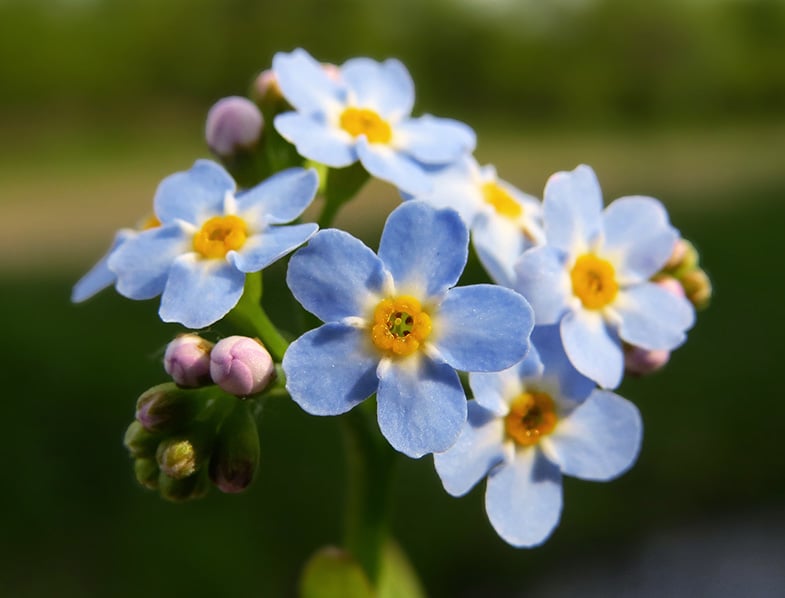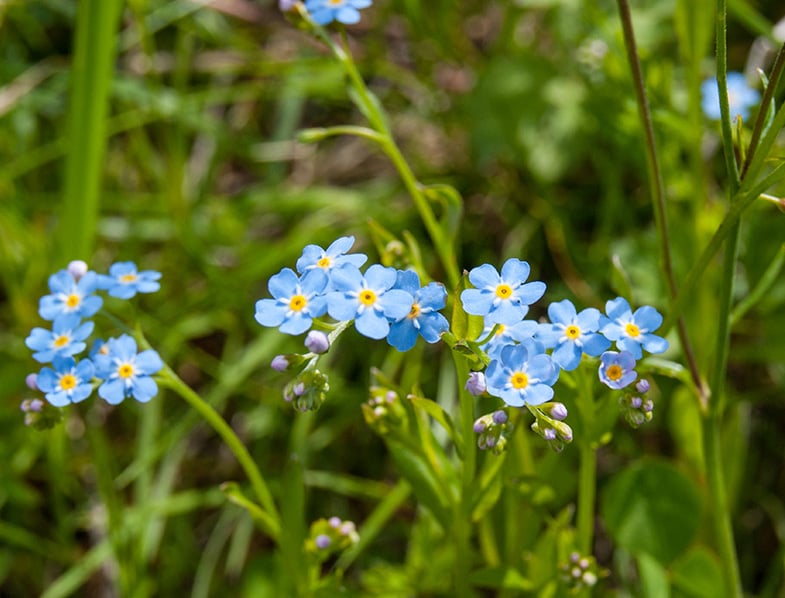When it comes to adding another pretty flower into your family, true Forget-Me-Not should be on your priority list! From cute blossoms to few growing requirements, this plant has all it takes to be the ideal companion to have around. Want to know more about Forget-Me-Not flowers? You came to the right place!
Myosotis scorpioides (syn. Myosotis palustris), usually known in cultivation as the True Forget-Me-Not or Water Forget-Me-Not, is a perennial species of flowering plants. This gorgeous flower belongs to the Boraginaceae family, sharing it with many other interesting genera including Amsinckia, Borago, Cerinthe, and Heliotropium.
True forget-me-not plants are native to several regions of Europe and Asia, but some cultivars are also common among North America. Big lovers of moisture, these plants grow mostly in humid environments like bogs, streams, rivers, ponds, fen, and ditches. They are perfect for water gardens and perform best in regions with frequent rainfalls.
About True Forget-Me-Not
- Historically, True Forget-Me-Not plants symbolize remembrance, luck, and protection. Many people associate these flowers with love, especially lost love.
- The specific epithet “scorpioides” refers to their flower cymes (inflorescences). When they are budding and during early bloom, they resemble a coiled scorpion’s tail.
- In traditional medicine, people used True Forget-Me-Not plants as a treatment for several conditions like bronchitis, nosebleeds, and whooping cough.
- These plants are deer-resistant and do not come with pest problems. Their delicate flowers are highly attractive to pollinators like butterflies.
- True Forget-Me-Not plants become dormant after bloomings. You should cut them back to promote healthy growth in the next year.
- They can thrive in almost every lighting conditions, a wide temperature range, and any type of soil as long as it is well-draining. They like their feet constantly wet.
- True Forget-Me-Nots are pretty toxic to humans and pets if ingested. For safety purposes, grow them in a spot where your curious beloved ones cannot reach them.

True Forget-Me-Not Features: An Overview
- True Forget-Me-Not plants belong to the Myosotis genus that contains about 89 species, subspecies, and varieties of flowering plants.
- They are erect and ascending herbs that can reach between 5.9 and 27.5 inches (15-70 cm) in height with a similar spread. These plants usually grow at a pretty fast pace.
- Their semi-evergreen and hairy foliage consists of shiny, oblong to linear leaves that emerge from woody stems. Their leaves come in various shades of green.
- In general, True Forget-Me-Not plants bloom from May to October. Their flowers appear as pink buds and become sky blue when fully open.
- The blossoms are very tiny, measuring from 0.3 to 0.5 inches (8-12 mm) in diameter. They have five petals with lovely star-shaped yellow centers and white honey lines.
- True Forget-Me-Not plants can make for excellent companions to other flowers that have similar growing requirements. The plants that go well with them include Iris pseudacorus, Caltha palustris, and Typha minima.
Growing True Forget-Me-Not
When it comes to their lighting preferences, True forget-me-not plants are not as picky as you might think. They can adapt to any light conditions that range from full sunlight to partial shade. In outdoor settings, plant your beauties in a location where they can receive at least six hours of bright and direct light daily. If you live in a region with hot and dry climates, you must protect them from harsh afternoon sunlight. Indoors, place your plants near a south or west-facing window to provide them with plenty of sunlight during the day.
In general, True forget-me-not plants thrive in mid-cool to slightly warmer temperatures. Although delicate in appearance, they can withstand temperatures that drop to 14 °F (-10 °C). These plants can also tolerate temperatures as high as 77 °F (25 °C), but not for long periods. In case of climates with extreme conditions, it is wise to grow your True Forget-Me-Not plants in pots and bring them inside at average room temperatures.
- The True Forget Me Not - Prefers Boggy Wet Areas
- Happily Thrives Along Stream Banks and Ponds
- Self-seeding Perennial That Also Spreads By Rhizomes Without Being Invasive
- Grown as an Annual in All Zones (5 - 9) Perennial - Full Sun / Part Shade
- Seeds are for the current and following growing seasons. Growing instructions and plant Images are included on the seed envelope. Seeds are stored in environmental conditions that promote seed life (Dark/Dry/Cool). Plant with Confidence!
- This is a fairly low growing perennial that is often used as a ground cover. Forget Me Not prefers moist meadows and grassy slopes. Occurs in subalpine elevations up to tundra ecosystems
- These low growing forget me not flowers only reach 12 inches tall and grow as a perennial in USDA zones 3 - 8.
- Deep blue petals contrast sharply with yellow, red or white interior of the flower. Blooms from late spring into summer These small plants have long leaves and petite flowers borne on top of the stems
- A must for the perennial flower grower! They are best planted with spring flowering bulbs such as tulips, daffodils and hyacinths to easily transition from spring to summer. Will grow in moist to wet soil but prefers well-drained soil with a neutral pH (7.0)
- Sowing Rate: 2 ounces per 1,000 square feet or 5 pounds per acre
- Guaranteed to grow - Plant in the Spring, Summer or Fall - Blooms throughout Spring and Summer
- Seeds are harvested in USA - non-GMO
- Easy to Grow! - Over 5,000 premium seeds - Forget Met Not (Myosotis sylvatica) biennial
- Wildflowers will bloom in approximately 60 days - Made in the USA
- Seed best planted within two years
Last update on 2024-09-20 / Affiliate links / Images from Amazon Product Advertising API
Many gardeners love True forget-me-not plants because they are not very attractive to the well-known problematic pests. Still, some fungal diseases like powdery mildew can show up on your plants, especially if you are growing them in pots.
This fungus shows its presence through many white, powder-like stains on the leaves and stems. If you notice this kind of infestation, you should remove all the unhealthy parts from your True Forget-Me-Not plants. In cases with a severe infestation, spray your plants weekly with a mixture of one-half insecticidal soap, one tablespoon baking soda, and one gallon of water.
Planting True Forget-Me-Not
True forget-me-not plants grow at a very fast pace and also spread like crazy! These beauties self-seed pretty easily, especially in wet environments. If you let them to their own devices, they can reach all the corners of your garden and affect the overall well-being of other plants.
The solution for this problem, however, is very simple! You can avoid over-crowding by planting them in a roomy spot where they can show their splendor without being invasive. Many gardeners prefer to transplant new growth in pots to solve this issue and enjoy their presence indoors too.

Although you can grow True forget-me-not plants in any type of soil, they perform best in light substrates. To grow healthy and happy, plant your babies in a general-purpose and rich soil that has great drainage. For potted plants, make sure the containers have drainage holes at the bottom to avoid waterlogging.
When you are growing True forget-me-not plants indoors, you must plant them in large pots to provide enough room to develop. If they do not have space to spread their roots, your plants will be a safe target for powdery mildew infestations. Due to their fast-growing habit, these plants will also require repotting once they start to outgrow their current pots.
Fertilizing True Forget-Me-Not
Unless your plants are not growing well or their foliage turns yellow in some spots, fertilizing is not necessary. Otherwise, feed your True forget-me-not plants with a mixture of one gallon of water and one teaspoon of 5-10-10 water-soluble fertilizer. Repeat the process once every month in place of one watering session until you notice some improvement.
Pruning True Forget-Me-Not
If you want your True forget-me-not plants to always look fresh and healthy, regular pruning can help you out. You can remove any unhealthy, damaged, or dead foliage parts to encourage new growth and control reseeding. Moreover, pinch off all spent flowers to make room for others to show up.
Watering True Forget-Me-Not
The best thing about True Forget-Me-Not plants is that they can tolerate as much moisture as you can give them! They will not hesitate to forgive their owners if they provide them with more water than needed. However, waterlogging is not ideal and a prolonged improper watering routine can affect their overall well-being with time.
But do not worry! You can avoid over-watering by always checking the soil in-between waterings. When the soil feels a little dry to the touch above, this is the perfect time to give your True forget-me-not plants a new round of water.
As a general rule, these plants do well when their soil is constantly damp but not soggy. They can also grow in up to 3 inches (7.5 cm) of standing water only if changed regularly.
Propagating True Forget-Me-Not
True Forget-Me-Not plants are so stunning and easy-going that they deserve a place in every gardener’s heart. It takes only to see them once and you’ll immediately fall in love with their charming presence! Now, asking the real questions: can we propagate True Forget-Me-Not and share them with our beloved family members and friends? Luckily for us, gardeners, these plants respond well to many propagation methods including division, seed sowing, or taking cuttings.
In general, propagation through division does not require much effort on your part. First things first, you must dig out your True Forget-Me-Not plants from the soil in spring. Once you have your plants out, divide their roots into as many parts as possible. Make sure you have at least one stem emerging from each divided part. After this process, plant your tiny True forget-me-not plants into their permanent positions and care for them as usual.

Propagating True Forget-Me-Not plants from seed is probably the most beginner-friendly method. All you have to do is sowing the seeds outdoors in a large container in late spring or early summer. Provide the seeds with temperatures of about 68 °F (20 °C) and regular watering to maintain the soil damp. With proper care, germination will occur after 2-4 weeks.
If you want to propagate True Forget-Me-Not plants through cuttings, you should use young shoots. In summer, look for healthy young shoots (new growth) and cut about 2 inches (5 cm) off them. For optimal results, dip the cuttings in rooting hormone before planting and place them in a shady border until root development takes place.
In Conclusion
In one way or another, True Forget-Me-Not plants find their place in every gardener’s collection. Not only do these flowers look adorable, but they can also adapt to almost any environmental and growing conditions. So, what do you like the most about True forget-me-not plants? Let us know in the comment section!



